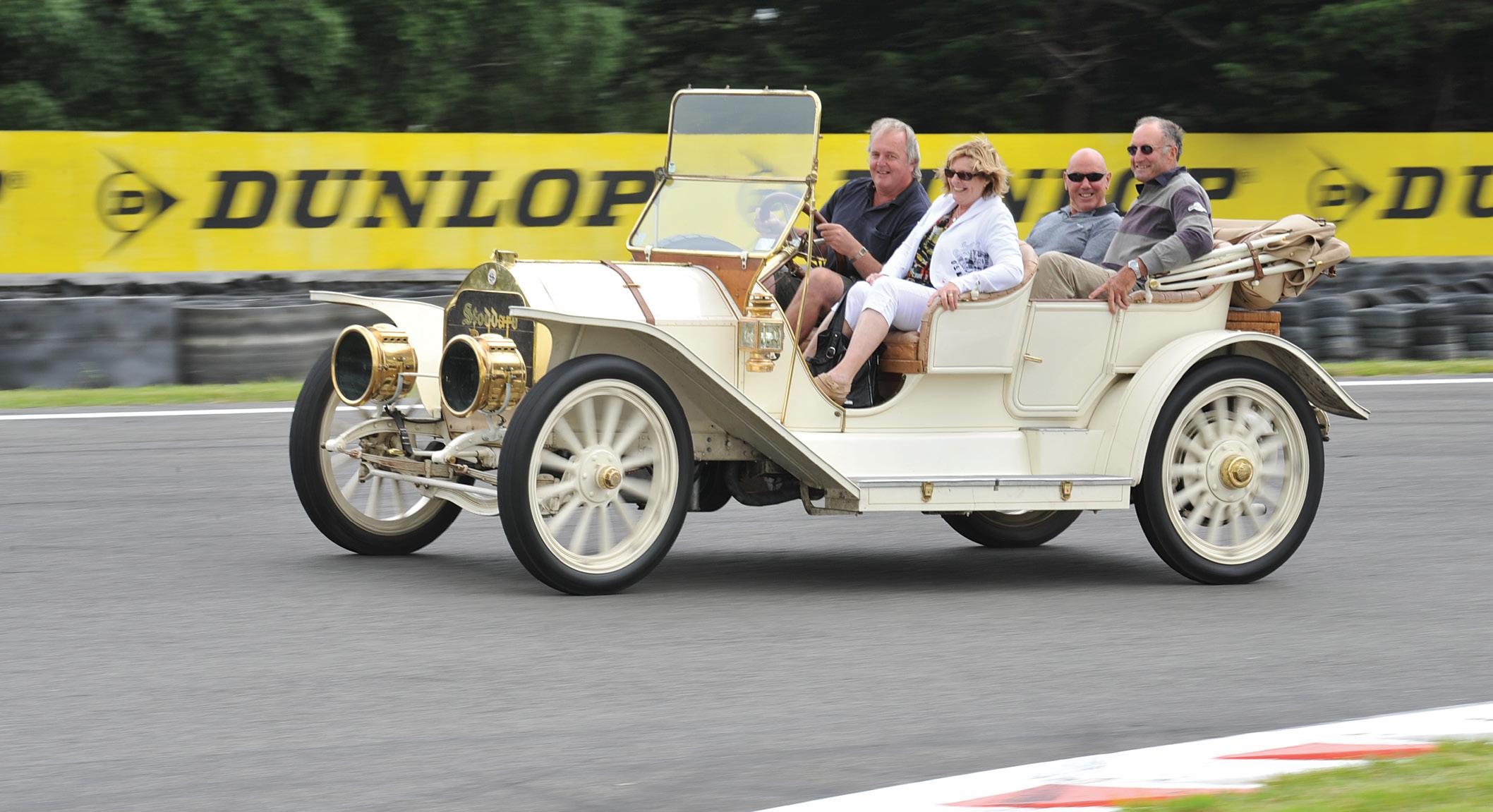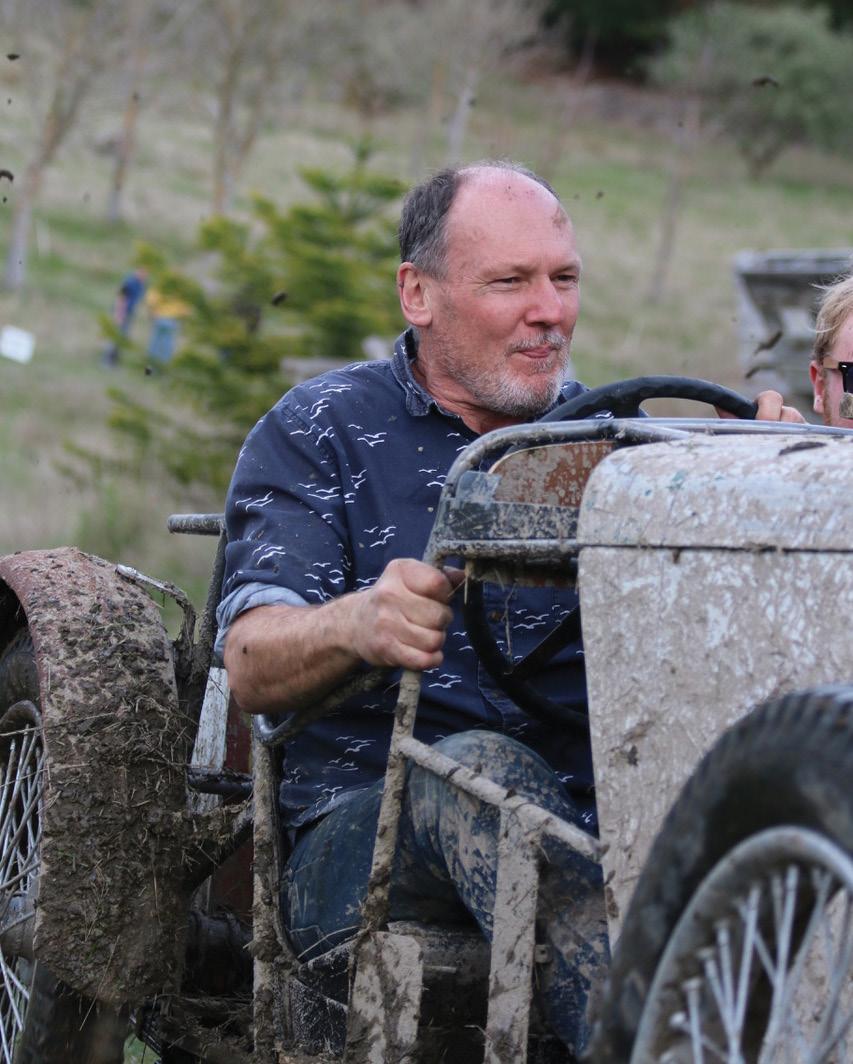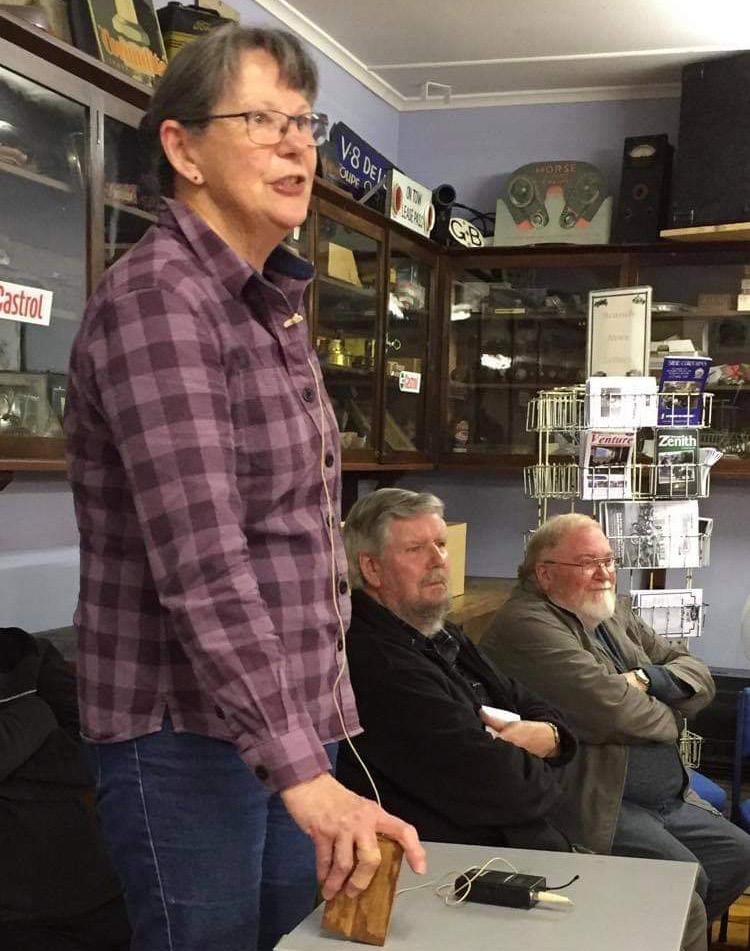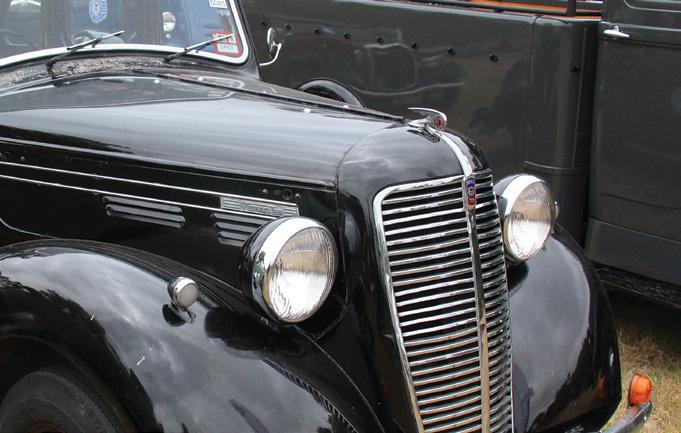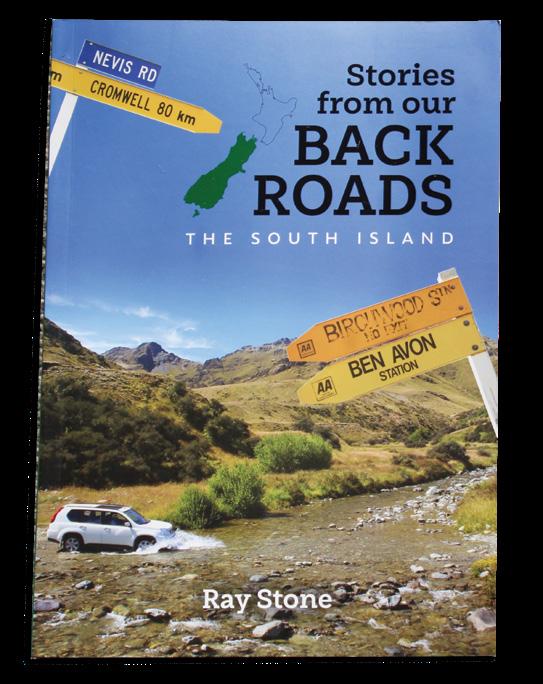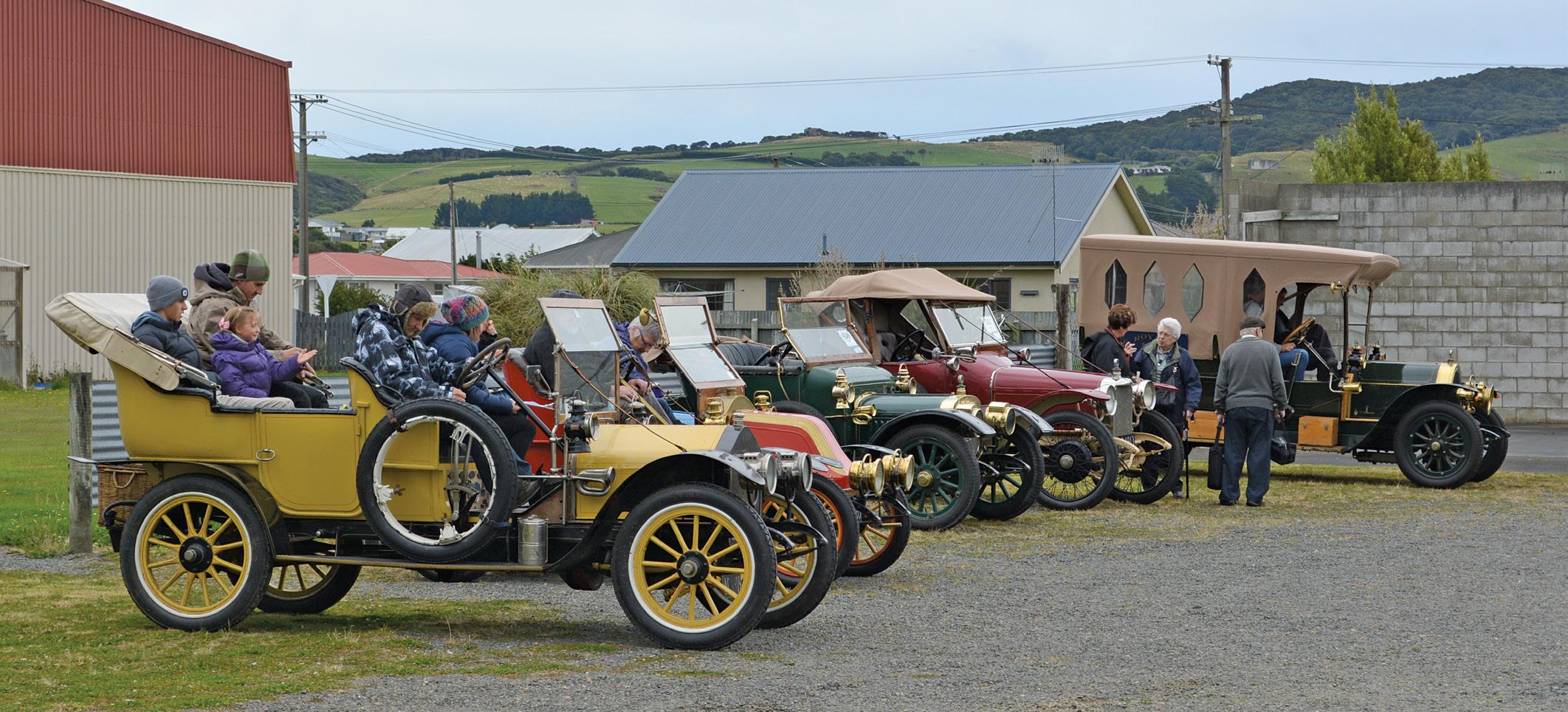
55 minute read
The Way We Were
s Kent Tubman K3 Magnette in the hairpin.
Continuing our series on the origins and very early events of the Vintage Car Club as recalled by Andrew Anderson
ANDREW ANDERSON VCCNZ FOUNDING & LIFE MEMBER

NATIONAL HILL CLIMB CHAMPIONSHIP 10 MARCH 1951 Our triumphant exit from Modern Motorsport management!
The late lamented NZ Sportscar Club in the persons of Trevor Wickham and Errol Ansell began the negotiations for New Zealand’s Big Hill, Paekakariki, in 1944 and its first event was staged in May 1946. It already had a “name”, having been an active competition in pre-Kaiser War days with an ftd by Sizaire-Naudin! It was a Big Hill of some 1½ miles and 800 ft and attracted entrants from all over New Zealand and Sportscar magazine has in its March 1949 issue the write up of the 12 February fourth event including the New Zealand Hill Climb Championship. In 1948 Ron Roycroft had set a new record of 2 mins 32.4 seconds in his Bugatti midget. The 1949 climb saw Roycroft again, this time with Rubber Duck Austin, Ken Hemus with 30/98 Vauxhall, BH Clinkard with Speed 20 Alvis from Auckland, Rob Shand, Del Drewery and Bob Christie in MGs from Christchurch and Halsey Logan from Nelson with the Singer Special.
Rob was hugely enthused and the murmurings for a South Island Big Hill was on, with the 2½ mile Governors Bay to the Sign of the Kiwi our vigorous target. Our two very successful and slickly run Kiwi climbs had “officialdom” well on side and it could be totally observed from an easily accessible area of the harbour face of Sugar Loaf Hill.
A dummy run was organised for 7 October 1950 with an invitation to Canterbury, South Canterbury and Otago Clubs of course with vintage classes. We arranged for Air Training Corp people with ZC1 radio sets as the best means of communication between start and finish, pits and the many intervening marshal points, saving an awful lot of cable laying! I was posted for a stint in the North Island on business and missed it completely. A good vintage entry involved a 4½ Bentley vs 30/98 Vauxhall duel, this time won by the Vauxhall. Hec McLean in the ex-Sammy Gibbons Invicta made ftd followed closely by Hec Green in the Wolseley. It was a very successful day with a lesson learned that ZC1 radios with their lengthy calling procedure were just too slow and cumbersome as a sole control and communication system for the hill.
With all lessons duly learned
s Kent Tubman getting the hockey stick from Pete Luxton.


s John McMillan Jeep Sport and Ted Reid Midget await the start.
s Tom Sulman’s 4C Maserati – changing plugs!
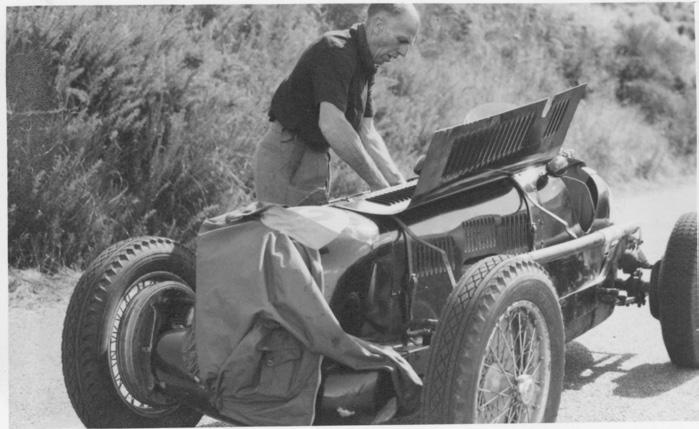
s Tom getting his FTD mug.
Ken Tubman and John McMillan. Mrs
Nuttal (Bob Blackburn’s mother) is behind.
and with the 1951 National Championship status duly confirmed for March 1951, we proceeded to concentrate wholly on the upcoming Centennial Rally and procession. The success of these made us decide formally:
1.
2. That the Big Hill event would be our last modern event.
That it must be the best ever!
As it was a National Championship decent prize money was necessary, and at Charlie Stanton’s suggestion guarantees were called for and immediately taken up. A vigorous advertising campaign was put in hand and comprehensive public viewing areas covered with PA systems all prepared including bus transport to the Sign of the Kiwi from the Sign of the Takahe terminus. Frank Blandford and Jack Nuttal’s team of programme sellers, by which the programmes acted as entry tickets, worked perfectly and the weatherman joined the team!
Control of the entrants, and the danger point marshals, was by telephone from the Sugar Loaf Hill HQ which also had Air Training Corp lads with ZC1 radios to deal with the service side of things; St Johns, crash crews and police. Mike Haggitt had two PA systems to keep the big crowd entertained and informed.
A 5.50 am start on telephone and timing cables set things off. Our 28 entries had been scrutineered at Dominion Motors the day before so our usual prompt start and slick running went all according to plan. The season had both 3rd Wigram on offer and also the very first real road race in Mairehau to attract both overseas and locals to Christchurch. We attracted two Australian visitors to add to the interest of spectators.
The Vintage section attracted only three entries. Bill Cope with the now very well-sorted Ulster Austin, Spud Jackson fresh from his Nelson successes with Ashley’s 30/98 and Roy Cowan from Wellington with the “Grader”, his weird rehash of the Lord Galway 35 hp straight 8 Sunbeam.
Moderns ran from Bob Blackburn and Colin Rudd’s Austin 7 racers, two dirt track Midgets, various TD MGs and Singers, to Rob with the Light Sports Railton and Jack Tutton’s XK120. The Aussie Ken Tubman’s K3 MG and Tom Sulman’s 4C Maserati, which pulled off ftd, with Rob Shand taking second place just pipping Jack’s XK120. Spud almost came next, just beaten by the McMillan Auto Union replica! Both Hec Green’s Wolseley and Frank Shuter in the ex-George Smith V8 Special had mechanical problems.

All 28 entrants had as many runs as they wanted and the final prize giving and dinner at the Governors Bay Hotel wound up that most ambitious, and thankfully profitable, speed event.
WHEN ALL THE STARS ALIGN
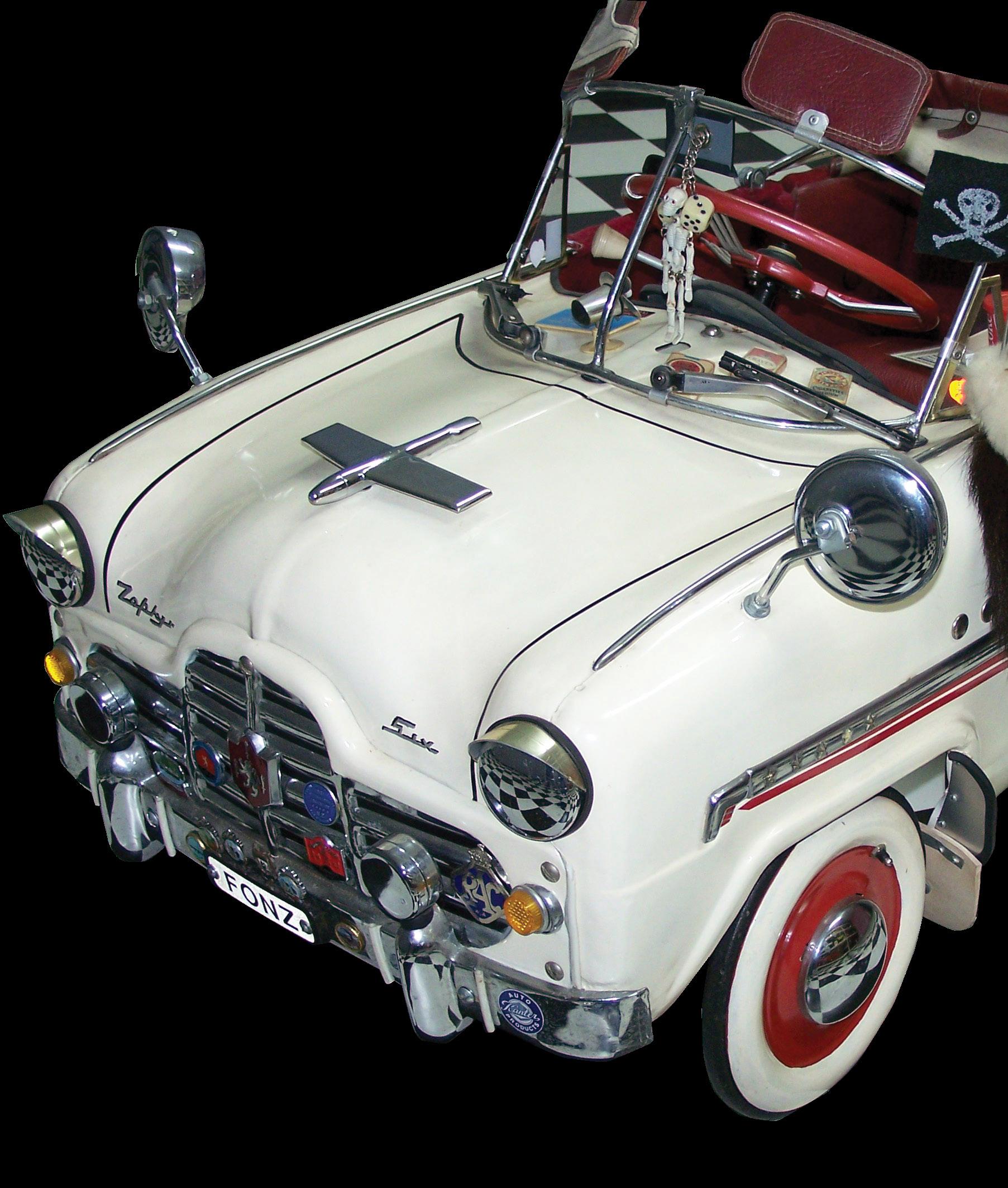
WORDS AND PHOTOGRAPHS GREG PRICE
I’m not entirely sure if Batman and Robin actually had anything to do with Lines Brothers back in the 1950s, but given the names that Tri-ang used for some of its range of Zephyr pedal cars, there was seemingly some emphasis placed on some of those stars when selecting appropriate names for their high-end models.
Initially three big Zephyr models were listed in the 1955 Tri-ang catalogue, and while clearly based on the Ford Zephyr Mk I models, they were not called Zephyrs as such, rather the range included names such as Neptune, North Star and Jupiter. Later, around 1960-62, a further model called the Meteor was added to the range by Cyclops in Australia. There were other models of this large Zephyr made (for example) in Canada under the Thistle brand (of Tri-ang), and two of them were called the Rocket 88 and the Comet. Cyclops began manufacturing Tri-ang products in 1952 as part of a major post-war restructure.
As the names imply, pedal cars were pedal-powered by and large, although some of the more sophisticated were chain-driven. Inexplicably one of the models covered in this article had a driveshaft and a two-speed gearbox!
But first, let’s look at the options available.
Neptune – Enclosed chain drive, rubber aeroplane mascot, dummy gear shift and a two-tone horn.
North Star – Cycle-type pedals, driveshaft and a two-speed gearbox (in both forward and reverse) brake, two-tone horn, mechanically operated trafficators and windscreen wipers, aeroplane mascot and AA badge.
Jupiter – Traditional pedal-crank, two-tone horn, dummy gearshift, AA badge, and mechanical windscreen wiper.
Meteor – Opening bonnet/hood, dummy engine (similar to that fitted to the Tri-ang/Cyclops Wolseley, Morris Oxford and Riley pedal cars), fillable petrol tank and radiator, fillable engine oil with dipstick, and a working handbrake.
It also had mechanical windscreen wipers, a two-tone horn and working lights, albeit fitted in the grille.
Having owned a full-sized Zephyr convertible for nigh on 42 years, finding one of these pedal cars was a must-do from day one, (many Zephyr owners purchased Zephyr pedal cars to complement their full-sized car) but these fancier high-end models were more elusive. The first example I spotted in 1981 was a Neptune then owned by a Zephyr enthusiast in Christchurch. I had obtained several of the smaller Tri-ang Zephyr pedal cars but this didn’t seem to cut it because of their being largely dissimilar to the real thing. In 1988 we finally located a well-used one in a farm paddock in Hampden, Otago. The (then) NZ Road Services bus driver following me at the time apparently did not appreciate my slamming on the brakes in front of him – if his subsequent horn blasting was any indication!
Luckily for me the pedal car’s owner was now too big for it, and was making the transition to horses, so my contribution to a new saddle for her was much appreciated (especially by her mother).
Initially the unrestored barn-find resided in the lounge until restoration commenced in earnest, and it became a miniature of our full-sized car, complete with everything scaled down to appropriate size, including the small packet of Craven A cigarettes, and a working scale-version of the original Echo 5-Star radio (which was a mini-cassette player in behind the replica drop-down facia). A continental kit and fender skirts were also fabricated from new aluminium oven trays. All the scratch-built
accessories were fabricated from Ford parts of one sort or another. The working hood’s material, door trim, spare wheel cover and seat upholstery were once the soft top for a Mk II Zephyr! While doing some research on these pedal cars, it became evident that there were other models in the range so, as collectors often do, we set out to find and purchase the other models. For those interested in pedal cars in general, particularly those from Tri-ang, there is a very good Schiffer 2001 book entitled Collector’s Guide to Children’s Automobiles, by GG Weiner.
Next up was another barn-find in the early 1990s, this time the North Star model with the gearbox, albeit with only one of the gears functioning, and missing a wheel. When new it was advertised as “The only pedal motor car of its type in the world”. As can be seen from the pictures, this was in sad condition, having clearly been discarded by its most recent child owner and abandoned in the garden. Upon dismantling the gearbox it was evident that there were some parts missing, not to mention the whole gear lever mechanism. It begs the question, “What on earth possessed Tri-ang to produce a pedal car for a three – five year old kiddie, with a two-speed gearbox with muck-metal gears, and no synchromesh?” Despite being advertised as “Synchro-speed” I couldn’t envisage a three – five year-old being able to gauge exactly when it was safe to shift gears. Being able to compare notes with another owner of a North Star, his too was missing one of the gears, and both our cars had been converted to single-speed. This was evidence enough that synchro-speed was a bit of editorial license in the advertising. Factory service manuals for these pedal cars don’t exist, and not being an engineer necessitated my laying all the parts out on the table and trying to work out what was missing, and of the parts present, what part they played in moving the car forward (or backwards). Having had Zephyr gearboxes apart on many occasions, it was a relatively easy exercise to work out how this one was meant to function. Firstly there was a main shaft with two gears – one large and one small, and then there was a lay shaft, also with two gears – one large and one small, but opposite opposed. By that I mean that the small one was opposite the larger one and vice-versa. Adjacent to the main shaft was the selector lever which moved a locking piece (similar to the synchromesh on the full-sized gearbox) backwards and forwards, engaging the smaller or larger
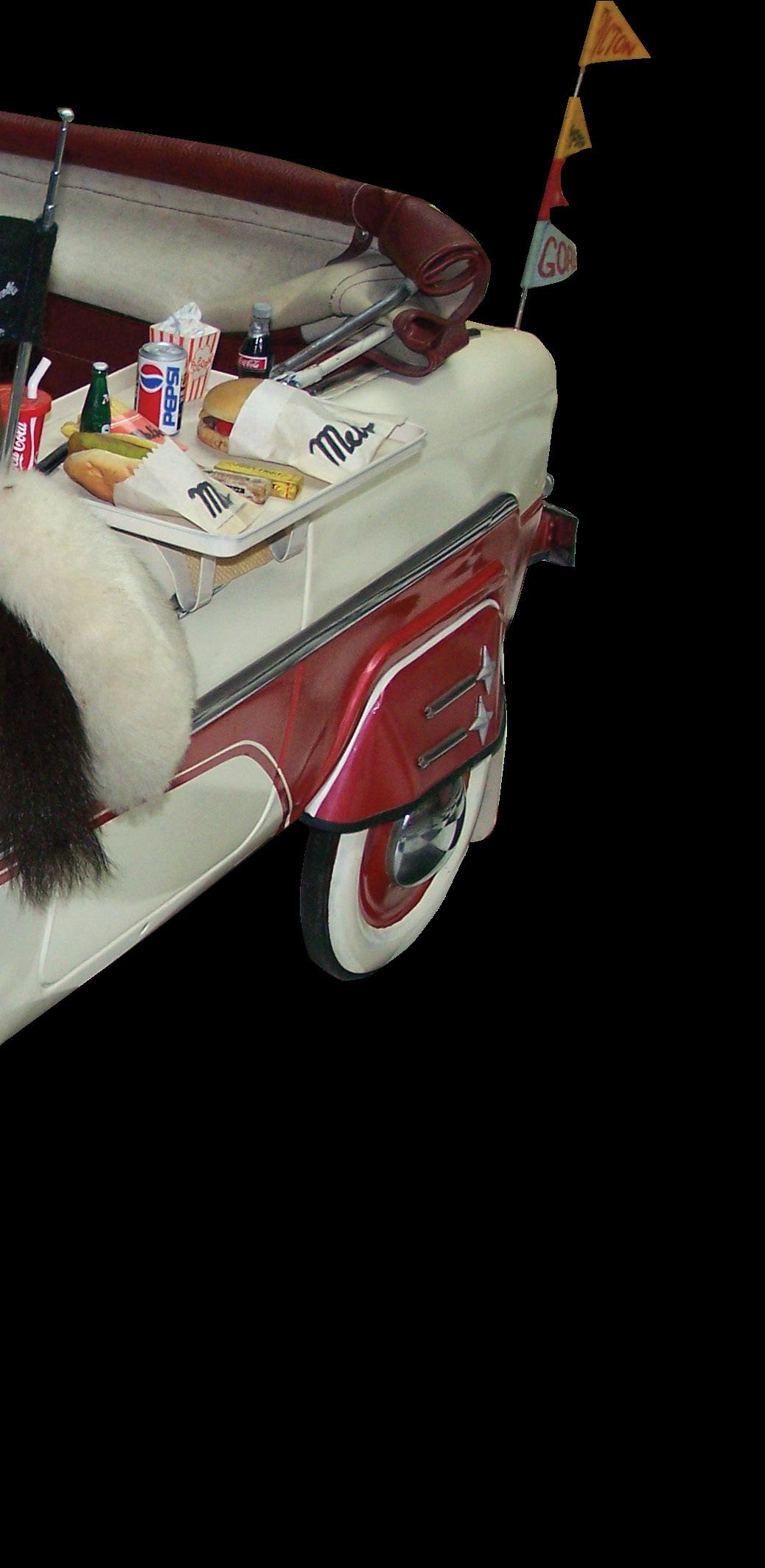


gear to facilitate the two speeds – high and low gear. As it was nonsynchromesh, any kiddie trying to move between gears while going forward was inevitably going to stuff up (read strip) the soft gear teeth. Thus the remedy for the backyard dad was just to remove one each of the small and large gears together with the gear lever itself and bingo, you had single speed only.
It took a while, but I eventually worked out that I could replicate the missing parts by getting both missing gears remanufactured, and fitting two fairly beefy return springs to keep the gears engaged. Early attempts at casting the missing gears proved unsuccessful so the option was to go for laser cut parts. As some of you might already know, getting gears laser- manufactured is no cheap exercise. So I got no change out of $300 for the two gears.
I then had to make the shift lever from scratch, and that involved measuring the distance between the differential and the shift mechanism so the rod could be threaded for adjustment purposes. Once assembled, a test drive was out of the question due to the absence of any suitably-sized kiddies, and I was too big. And in any event I wasn’t going to let an otherwise well-intentioned kiddie loose in my project. So I had to be content with setting it up on the barbeque table and pedalling with one hand while changing gear with the other. From memory, one revolution of the pedals equated to two revolutions of the rear wheels in first gear, and three in second. That seemed to work okay and indicated that
my gearbox rebuild had been successful. All that remained was to complete the re-assembly and repaint in a bright red. The gearbox and drive-train were painted blue for contrast. The North Star decals were easily enough reproduced because the original stickers were still evident, so a photograph and a few pictures of the fullsized pedal car were enough for my computer graphics expert (Let’s Get Graphic) to make some nice new ones.
So that was two down and two to go. Next was a Jupiter with the traditional pedal-crank mechanism. Because of the earthquakes from 2010 onwards, this example was stowed in the garage rafters for a few years, as the priority was sorting out our earthquake claims. Then a Meteor (with the opening bonnet and dummy 4-cylinder engine – same as used in Tri-ang’s Morris Oxford range) was bought at the McLeans Island Swap Meet in 2016. Given that a Meteor was superior to the Jupiter in terms of additional features, it became a work in progress. We haven’t decided on a colour scheme yet, as the temptation is to paint it the same as our Mk I sedan, but from a purist’s perspective originality should be paramount. While the working lights are situated in the grille, the guards looked a bit funny without lights where they are situated on the other models, so the extra lights were added. Interestingly this pedal car was bought by the previous owner in the United States, so it is pretty well-travelled.
On the to-do list is finding a rare-as jerry can like the ones on the Tri-ang Jeeps, which were fitted on the inside of the car, fabricating some new bonnet hinges, fitting the engine oil reservoir, fitting some bulbs to what are now the spotlights, fitting the handbrake mechanism, and completing the surface rust removal from the other half of the grille. I also have a spare Mk 2 bumper which can go on the back, complete with over-riders, as the rear end looks a bit bare without a bumper. And of course flat-dash early Ford Zephyr glove box emblems make perfect scaled-down grille badges. We also have an original pedal-car-sized AA badge that was available back in the 1950s, primarily for the Austin J40s.
The big advantage with pedal cars is that they do not take up anything like as much room as full-sized cars, don’t take anything like as long to restore as their full-sized counterparts, and restoration costs are considerably cheaper. So, what are you waiting for?


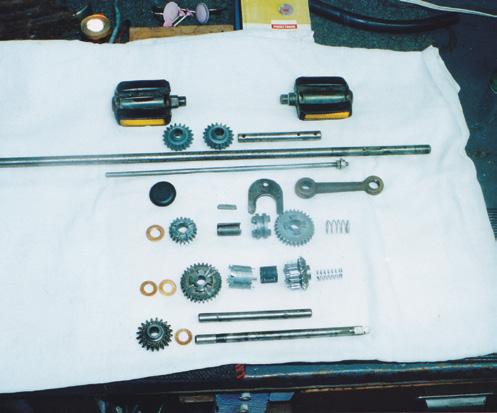

SPECIFICATIONS
Length: 40 inches (102cms) Wheels: 8 inch diameter artillery or balloon disc (depending on the model) Drive: Pedal crank / bevel gears with shaft drive / chain driven pedals Lights: (where fitted) 3 volts Horn: 1.5 volts Accessories (depending on the model): Handbrake, rubber bonnet emblem, Jerry Can, wipers, dummy gear lever, and an upholstered seat base. Maximum Speed: How fast can you pedal?

AGM NATIONAL 2020
Despite lockdowns and travel restrictions the club managed to hold a highly successful 2020 AGM in Whanganui.

WORDS CHRIS LEITH
After some 29 years membership of the VCC it took an arm twisting nomination to the position of Hon Sec-Treasurer to finally get me to attend my first VCC National AGM. Very ably hosted by the Wanganui Branch, led by their Chairman, Bruce Ardell, and held in the Kingsgate Hotel, the events of the weekend ran like clockwork. The conference room, foyer and main entrance were very well decorated with cars, motorcycles, and motoring memorabilia.
Because the current Covid-19 lockdown situation prevented a number of the North Island delegates in particular attending as well as attendees from the Deep South there was one of the longest ever apology lists for the Friday Executive meeting. The AGM on Saturday fared little better, with nearly 50 apologies.
The highlight of the AGM was the bestowing of Life Membership upon Rod Brayshaw and John Coomber. The John L. Goddard Trophy was presented to Don Muller. Another highlight was being addressed by Founder and Life Member Andrew Anderson. His very thoughtprovoking message was well received.
The business of the day was very efficiently conducted by the president, Diane Quarrie, with both the Executive and AGM agenda’s being completed by about 1.15 pm Saturday afternoon.
Sunday saw the Wanganui Branch conduct a tour for the out-of-towners. We were treated to being chauffeured in club members’ cars as we visited two places of interest. The first was a storage facility and an old warehouse next door owned by Mr Rick Dennison. Rick gave a rundown on the history of the brick storage facilities – initially built to house petrol and oils around WWI era and now used as vehicle, machinery, and other memorabilia storage. The warehouse next door was refurbished in the 1970s into the national HQ of Warnocks Ltd, a travelling shop and mail order drapery and clothing company. Warnocks was finally liquidated in 1992, 106 years after being founded originally in Wellington. Rick and his wife are converting the Warnocks building, which is a
JOHN L GODDARD TROPHY RECIPIENT – DON MULLER
Don’s contribution to the club archive is above and beyond just keeping the collection in order, he is also currently entering thousands of photographs into a dedicated digital database.
They are reproduced in excellent quality and cross-referenced to several key words so that members can retrieve photos by name, previous rally numbers, or owner and previous owner.
Many long-playing factory recording discs, as used when new models were introduced, have been placed on memory sticks. Some of these vinyl discs are very old, requiring much research and locating obsolete record playing equipment.
His dedication to the task sees him at the archive every Friday morning, and spending countless hours at home refining the huge collection into user-friendly, memberaccessible data, suitable for members with only basic computer skills. Don was proposed for the award by Alan Wills, who wished for public acknowledgement of Don’s great work and dedication.
National President Diane Quarrie with the pilot, Richard Harding, and Andrew Anderson.
perfectly preserved “time warp of 1970s award winning interior architecture”, into a museum and private living quarters. The second place visited was the home of the son of the founder of Wanganui Aero Work Ltd, Mr Richmond Harding. He gave a talk about the family business, established in 1950 by his father Wally, and sold in 2004 to Ravensdown Fertiliser. After his talk he treated the assembled members to a display of precision flying in his own ¾ scale Spitfire aircraft – and a more accurate display one would be very hard pressed to find anywhere.
Soon it was time for the short trip back to the VCC Wanganui Branch clubrooms for a very well presented lunch, then the drive back to Palmerston North for the flight home to Christchurch.
Many thanks to the club members who freely gave their time and vehicles to transport us to the displays, and a huge thank you Wanganui Branch, I thoroughly enjoyed my first experience at a National AGM.
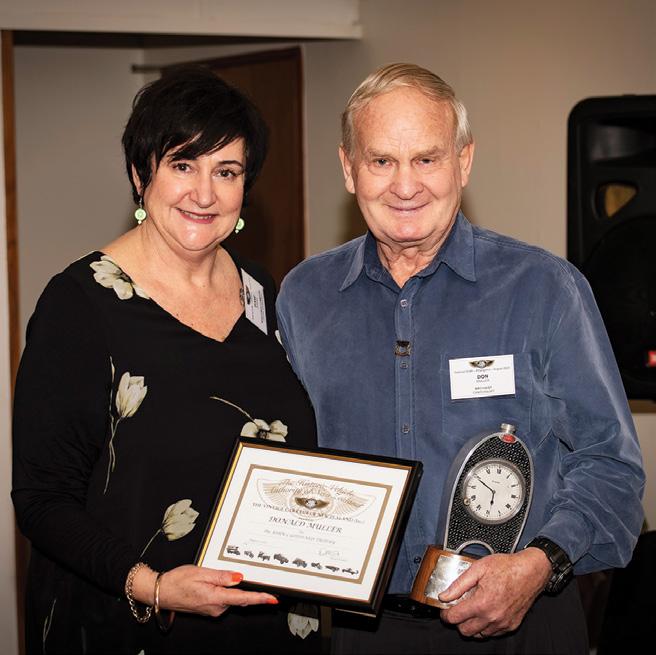
TWO LIFE MEMBERS HONOURED
The VCC is a club run largely by volunteers, without the countless hours of work donated by members we would not have the active organisation and long list of achievements that exist today. The 2020 AGM saw the conferring of life membership on two of our members who have devoted many years of outstanding service to the club.
JOHN COOMBER
John was approached by the then National President, the late Frank Renwick, to stand for the position of Hon. Secretary and was elected in August 1994. In 1997 the position was changed to Hon. Secretary/ Treasurer. John held that role until he became National President in 2009, a position he held for six years, followed by one year as Immediate Past President
At around the same time as John became Hon. Secretary, it was estimated by the late Ian Docherty that, at best, the Vintage Car Club had total assets of $15,000 (that’s money in the bank and any property). When John stood down the Club had over $1 million in the bank plus a property still worth $400,000 to $500,000. We were at that time over one-hundred times better off than the estimated worth of the Club 20 years previously.
While this was of course not just down to John, his sound and steady management was a contributing factor. In 2001 John was part of the team that negotiated the purchase of our present National Office in Aberdeen Street, Christchurch. This proved to be a very sound business decision. Even after being paid out for the damaged building due to the Christchurch earthquake, the value of the land, because of its commercial zoning location, is still increasing exponentially. John was also one of the group that did a lot of the decorating of the building when it was initially purchased.
John also joined the Beaded Wheels committee in 1995, a role he still continues twenty-five years later.
He was a policeman for 37 years, and his friendly approach and negotiation skills that were obviously part of his job in the Police were brought very successfully into his roles within the Vintage Car Club.
John’s family, in particular Christine, have been a big part of his VCC journey and have supported him in all of his roles. The Coomber family have been such a friendly and welcoming host to all of the management team (and others) who have stayed with them over the years.
When John stood down in August 2016, he had been a member of the Management Committee for 21 years, 14 as Hon. Secretary/Treasurer, six as National President and one as Immediate PastPresident. That was roughly one third of his life at that time! That is an outstanding

commitment to our Club and a great achievement.
Since standing down from his role on the Management Committee, John has held the positions of Secretary and then Chairman of Canterbury Branch.
John has played a significant part in the success and history of the Club and we consider him a most worthy recipient of Life Membership of the Vintage Car Club of New Zealand.
s Rod and Jill Brayshaw

ROD BRAYSHAW
From the 1960s the Club had a system of registering and dating club eligible vehicles, and all members were encouraged to have their vehicles recorded as an indication of the vehicles authenticity. Over the years the system became modified to encompass the PV and later PWV acceptance. These vehicles were required to pass a thorough inspection before acceptance as club vehicles.
The need for an identity card was initiated by then then National President, the late Alastair McIntosh, and he and Roger White did some preliminary work. But it only gained momentum when the late Frank Renwick became President.
FIVA had updated their ID Card application and Frank, along with current Registrar Don Dennis, thought it would be good to do something along the same lines.
Don felt that he would not be the right person to do this, but that it was definitely the way to go. He advised that he would not be seeking re-election, but he thought he may know someone who would be good to take over his role and lead this process. That person was Rod Brayshaw.
Rod was elected as Registrar at the AGM held in Whangarei in August 1996 and the Executive at that meeting unanimously passed a decision to develop a registration and dating system suitable for New Zealand use.
Rod, together with Frank Renwick and with help from Julie Cairns from National Office, began work on the foundation for what would become the Vehicle Technical Code and the Vehicle Identity Card (VIC) system.
This was a huge and all enveloping project with enormous commitment and input from Rod. It would be fair to say that without Rod’s skills and extraordinary work ethic the VIC system would not have ever got off the ground.
It would also be fair to say that initially this proposal did not receive overwhelming support from members and Rod and the other members of the Management Committee spent from late 1998 to March 1999 presenting a travelling road show to all the branches in New Zealand, which in itself was a huge commitment. The first data input was in August 1998 and the first VIC issued in early 1999.
In developing the system Rod had continual dialogue with the Land Transport Safety Authority (as the NZTA was known in those days), to ensure that they were completely comfortable with the planned VIC system introduction. As a result of this dialogue, the LTSA officially recognised the Vintage Car Club as the Historic Vehicle Authority of New Zealand.
Rod also negotiated with the New Zealand authorities to remove the “Vintage” term from legislation and replace it with the term “Historic vehicles”. This was done to correct the impression that old vehicles were vintage vehicles, and to separate out all our Club vehicles that were 30 years and older as Historic vehicles.
There is no doubt that the VIC will be an increasingly important document as a conduit with NZTA for keeping our historic vehicles on the road in New Zealand.
With the support and backing from the VCC Management Committee, Rod attended FIVA meetings in Europe which gave him the opportunity to get to know leaders from other countries and to discuss the many challenging issues that they were experiencing or likely to face in the future.
Rod’s expertise did not go un-noticed, and in November 2016 Rod was elected to the FIVA Technical Commission, a position he continues to hold. The high regard in which Rod is held throughout FIVA, and the valuable contribution that he makes to the world-wide scene, cannot be down-played. We are fortunate indeed to have Rod with his knowledge and expertise advocating on our behalf both in New Zealand and overseas.
The Vintage Car Club’s VIC system was ahead of anything else developed in the world. We are the leaders in this field and the world is now copying us.
Rod continues to maintain strong relationships with the NZTA, anticipating issues as they arise, advocating on behalf of members and lobbying on behalf of the Club to ensure that any legislative changes do not adversely affect us.
He also regularly attends the meetings of the Low Volume Vehicle Technical Association (of which the Vintage Car Club is a founder member), and liaises between the two organisations and again, reports back any concerns or information which could affect the club.
Rod is always available to members to assist with issues around obtaining a VIN or warrant of fitness.
He has carried a huge work-load and the scope and complexity of his endeavours is legendary, and we know that this has been to the detriment of his own business. We also know that he couldn’t have done it without the backing of Jill and his family, and we acknowledge and sincerely thank them for supporting Rod over the years.
Rod has held the position of Registrar for 24 years and there is no-one more deserving of the award of Life Membership of the Vintage Car Club of New Zealand.
Maglita FD and early E Type
WORDS AND PHOTOS PAUL RADMALL
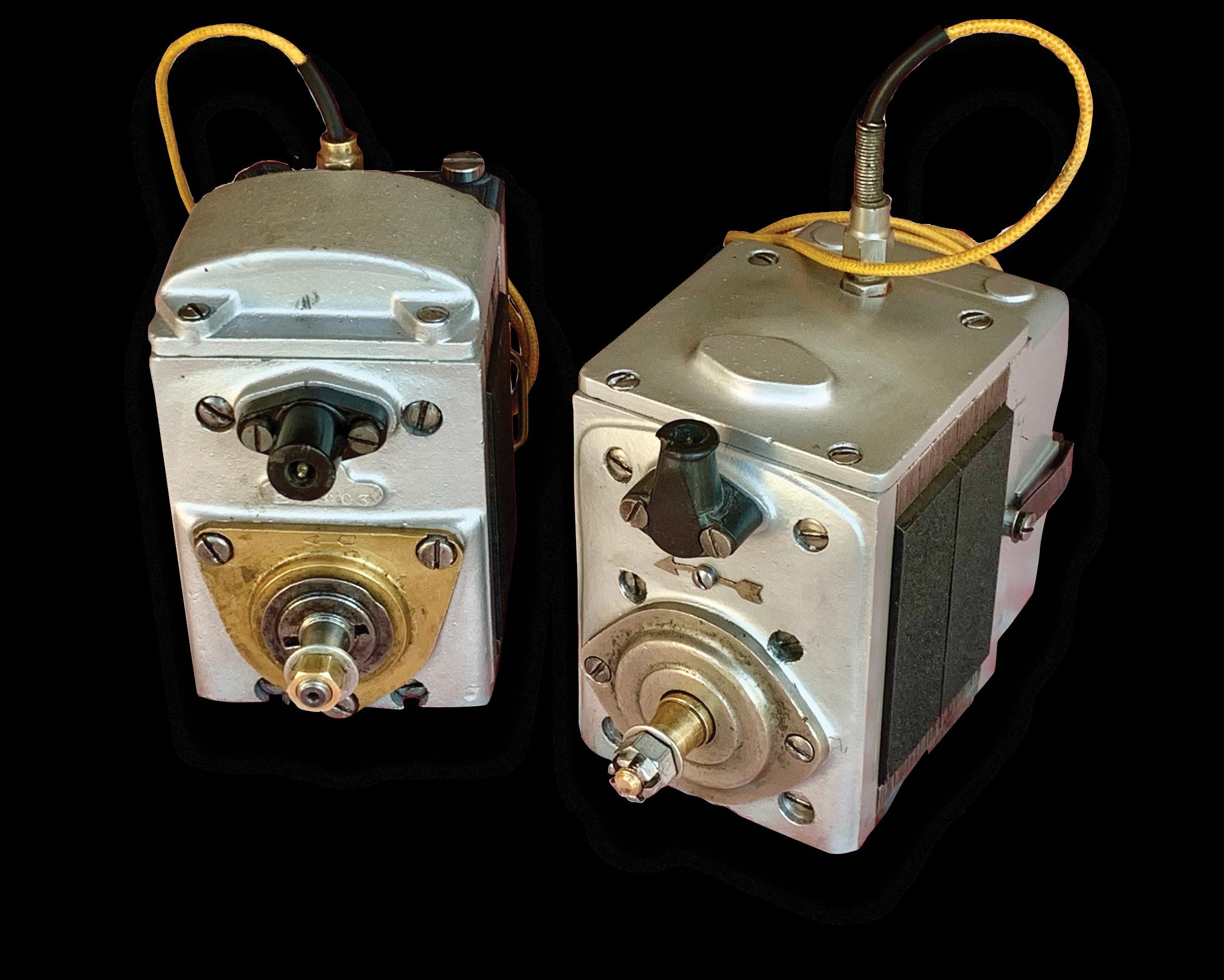
IN PRAISE OF THE MAGLITA
I had heard the name but never seen one, and here were the remains of three.
Tiger also explained that they had been left for good reason, in his words, “They are supposed to be a magneto that also provides battery charging and lighting current for motorcycles. Unfortunately they had a reputation of not providing both at the same time.”
To someone like me that is a red rag to a bull. I felt that I just had to have a look at them and understand why he made the comment, and of course, prove him wrong.
So what is a Maglita? Well it is a very early attempt at providing electric light to a motorcycle world that was used to acetylene-based

lighting systems. The ML Magneto Syndicate in Coventry UK designed and produced them, starting around 1920 through until 1939. Lucas bought the company in 1930.
The novel feature was that the unit provided a magneto and lighting generator with only one rotating part. Lucas produced the MagDyno unit which did the same thing, but had two distinct units, a much larger six volt generator and a separate magneto, coupled by gearing.
The Maglita sales information claimed simplicity and hence greater reliability for the system. Since they were produced for around 20 years there must have been some substance to the claims. So getting back to my heap of junk, I rapidly found that apart from the usual jokes there was not much information available. As is usual with these things you spend hours on the net, and eventually I got a result. BarnStormers.co.nz yielded a couple of ML technical leaflets that described units very similar to the heap of junk.
To my delight, the heap turned into an insight into how cleverly the engineers of the time had got so much out of so few components.
What they had done was to use a simple disruption of the magnetic field from the permanent magnets to provide the ignition system function and as this occurred, the winding on the armature cut the flux of the same magnetic field, producing the DC lighting supply. In other words, wiggling the bit of iron (the armature) caused the spark and the rotating of the same armature, with its winding, gave you lights. Magic.
I love elegant thinking like this, so I felt that a restoration had to be done. It proved to be a difficult job with virtually zero chance
of commercial gain, and a good chance of humiliation, so altogether perfect.
THE REALITY


The three units turned out to be 2.25 really, as one of them was almost corroded away. The other two, potentially, could be rotated and a lot of parts had been robbed over the years. Interestingly, one of them s Plywood brush holder. had a brush mounting plate made from rotten plywood and a few nails. It is amazing what people do when they are desperate. After a lot of careful work with an impact screwdriver I was able to assess the task. One of the units was a very early Type E and beautifully made, with elegant brass pressings, nickel plating s Type E as found. and no expense spared on the construction. The other was technically more advanced, but economies of production were apparent. What I had was an early Type E, 4 volt unit (approximately 1923) and a Type FD 6 volt unit (approximately 1929). The voltage refers to the voltage of the battery fitted to the system.
They must have been a revelation to riders used to acetylene lighting even though their lighting output was just around 14 watts.
THE RESTORATION


There was no alternative to a complete ground up restoration, so every part was carefully removed and examined. Firstly, the armatures had serviceable windings (they are very low voltage) but one of the drive shafts was loose and the thread broken off. The other had severe corrosion of the contact breaker cam. A new shaft was made and silver brazed into the bronze end-piece. The contact breaker cam proved to be a tricky job in the tool and cutter grinder, but in the end was made serviceable. Otherwise the fitting of new ball bearings all round worked wonders, and all could be smoothly rotated again.
The early machine had a fabricated commutator made from huge blocks of solid copper and Paxolin strip. Yes,




it did fall apart in my hand, but all was well in the end after careful finish machining of the armature assembly.
Electrically and magnetically the design is very interesting. ML had shaped all the pole pieces such that they had to be precisely stacked in the correct relationship to each other and then held in a jig to permit accurate assembly. Easily done at the factory, I am sure, but a little frustrating to the apprentice Maglita technician.
The ignition coils are a small bobbin around an iron core that just slips into the top of the unit. The bobbin is wound with the usual primary and high voltage secondary windings, just like a normal magneto, except that it is stationary. The rotating armature causes the flux in the iron core to reverse at the right time and induce a voltage in the primary coil. This is interrupted by a pair of contacts in the usual way, and hey presto, the secondary produces a high voltage spark at the plug. The coils for these two machines were in fair s Old FD coil. condition despite their 100 year history. It was decided to rewind the coil for the later machine and compare the performance with the original coil in the older unit. The older coil appeared to be in better condition and both tested reasonably ok electrically. s FD core ready for rewind. The rewind followed its usual course and lots of corrosion was found during the strip down. I have observed the green copper corrosion often when stripping magneto coils, even the enamel coating on the old wire is very brittle and easily crumbles. Clearly, s New coil for the FD. coils in this condition will
s New contacts and blade

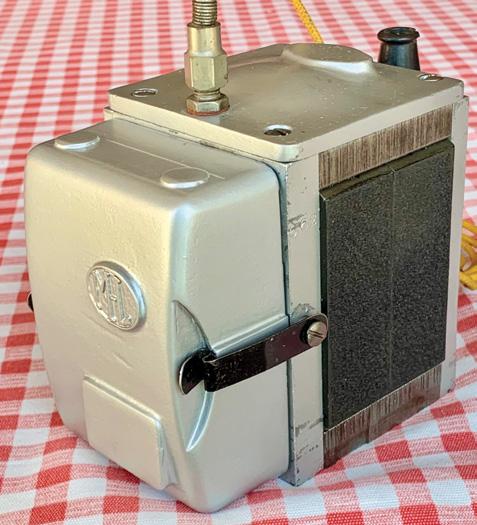
not stand much handling and could not be relied upon if part of a rotating armature magneto. I took the opportunity to alter the winding formula a bit to see if I could get a better spark out of the design. Having completed the rewind to Marlborough standards, I can be reasonably confident that s 3D Printed Cover in ABS. the insulation will withstand the higher voltage I hoped for.
Unfortunately the contacts and spring steel blades had been robbed years ago from both units. These bits are always difficult as they are spares and tricky to make. Anyway, it is all part of the fun. In this case some spring steel was carefully annealed in a temperature controlled furnace, shaped and polished. The finished blade was then hardened and tempered in the furnace and it adopted that nice shiny blue colour. New tungsten points were riveted into place and Bob’s your uncle. Fortunately, they now work well.
The capacitor on the older machine was spectacular in appearance, but unserviceable, so had to be replaced with a modern unit. The 1929 machine had a conventional tube shaped capacitor that tested very well indeed, so was retained.
Other sundry parts were made, and the brush gear manufactured. Carbon brushes can usually be made from modern ones carefully re-profiled. Tiger found some brush springs at our branch, so I was glad not to have to make them.
Covers for the contact and electrical area were something else. The early machine was fitted with a cast aluminium cover, which of course was missing. The later machine has a Bakelite cover. Both are made of Unobtainium as far as we are concerned.
The solution is to measure carefully and draw a new cover on 3D CAD. The resultant file can then be 3D printed as a pattern, or the actual final object, if the materials are suitable. Fortunately, this is one of the areas in which I have had professional experience and the process can be used for lots of unobtainable plastic parts. Additive manufacture like this has to be the way forward in these increasingly isolationist times.
TEST AND ASSEMBLY



There were no real dramas. Both units went together well and mechanically felt good. Now we come to the moment of truth. First, each was re-magnetised, which is a tricky operation requiring careful positioning of the already assembled armature and a controlled series of operas 5 mm Spark at 120 rpm. tions. Once re-magnetised, each unit felt really “notchy” when turned by hand, a good sign. I really could not resist a bit of late night work at this stage as I was curious to see how well they worked. The moment came, I s Good primary waveform. flicked the shaft and yes, a spark! Not only that, but when I set the unit up in the test rig it almost passed the aerospace test of a 5mm spark at 100 rpm. It actually managed a 5mm spark at 120 rpm. I am sure it did not manage that when new. The older machine, with the s Regular Sparks at 4000 rpm. original coil did not manage the test, but did achieve a 3mm spark at 120 rpm. Maybe I will rewind it one day.
Furthermore, there was output from the lighting coil at the same time as there were sparks at the plug.
Is it time to gloat? No, not yet, I have been caught out too many times. So I let the machines run for a day or two on the test rig and fortunately they kept working at various outputs and speeds to give me confidence.
The time came to gloat, so I called Tiger and told him he could have sparks and light at the same time. He was delighted and so was I.
OBSERVATIONS
I keep telling myself I did all this work for fun, but I suppose eventually I will have to pass them both on to people who need them for an early, single cylinder, British motorcycle project, giving it that extra bit of originality. The reliability should be similar, if not better than most magnetos due to the simple design.
You might say that the lighting output is pathetic by modern standards and I would agree except for the following three letters, LED.
I conducted The Maglita bench tests with an LED headlamp bulb and 6 volt battery have shown that the lighting output and battery charging capabilities are well up to the mark, if LED bulbs are used. A bit of hidden electronic trickery and imaginative thought should yield a reliable lighting system for an early motorcycle.
THE MORRIS DANCE WORDS AND PHOTOS ROGER LUSBY

As with every dance, there is a circle to it, and everyone eventually comes back to where they started from. So it is for the story of my first car, a 1934 Morris Cowley 12/4.
I became involved with this car when I was 14 years old. Living in the country, seven miles outside the town of Roxburgh, I needed transport. I was keen on a motorcycle at the time but my mother and father were cautious by nature, and believed motorcycles to be unsafe in the hands of teenagers. They made arrangements with Norman Dennison, the owner of Walden Motors, a small motor repair garage in Roxburgh, to purchase an old car owned by the leading hand in the workshop. Later the following year it was my luck to become an apprentice mechanic in this garage, but at the time of purchase, that good fortune had not been realised.

s The mahogany dash board and leather seats add class to the interior.
Jack Egerton was the leading hand at Walden Motors, and had just purchased an immaculate Austin A95 from one of the local senior citizens of Roxburgh. I still remember the smell of that car, real leather trim and as pristine as the day it was built. The car could really go too, and I vowed one day I would have one of them. I did manage it, but that’s another story.
Jack was not impressed with the Morris, “Had a soft head” were his words, and he had learned that the crown wheel had spat a bolt out one day, causing some noise and a hole in the diff backing plate. I think this shook Jack’s confidence in long distance travel in the Morris. Anyway, his loss was my gain, and with my father’s help £75 changed hands and the Morris was mine.
This car most likely started its life in New Zealand in Dunedin, and if anyone can supply more information about this supposition, I would love to hear from them. The first local owner in the late ‘40s was the Dance family. Jack Dance was a local orchardist and had traded the old Morris on a 1952 Morris Oxford. He also owned a beautiful old Reo 1500cwt truck, and if I knew then what I know now, I would have a shed full of these beautiful old machines. Anyway, the Morris went to Dunedin to be owned by one Doctor Stewart for a time, before he traded the car again on a Jaguar from Viv Angow of Angow Motors. Norman Dennison was a friend of Viv’s and arranged for the purchase of the car by Jack Egerton. Another interesting fact is the car appears to have been the first car of everyone who owned it.
My first recollections of the car was again the wonderful smell of leather seats, mixed with that sweet oily smell of the old English machinery. I loved the detail of the car, the mahogany dashboard and door caps, the netting mesh above the driver where daily papers and important documents could be stored, the temperature gauge on the bonnet, and the difficulty I had keeping the car in a straight line above 40 miles per hour. This was later remedied by welding up the cracked brake backing plates on the front wheels, where the steering bolts on. This came back to haunt me 45 years later when I purchased the car again, as my welding attempts carried out as an apprentice had failed. However I remembered the feeling of the wandering steering and with a good re-weld, everything was under control again. I did manage to get 75 miles per hour down the Hydro hill after I fixed the steering the first time, but how I managed to get around Weatherall’s corner at the bottom of the hill, I will never know, probably something to do with the blind confidence of youth.
Anyway the car was now mine and independent transportation was bliss. The back seat could be arranged in such way that I could get a lilo and sleeping bag into the space and many a scout camp night was spent in comfort. Rock and roll band practices, trips to places I could only dream of before, and girls were now on the trip list. I didn’t get far with the girls, but the trips were many and fun.
I raced a plane taking-off from Momona Airport once, and nearly rolled the car at the end of the runway - I don’t think we could get away with that nowadays. The car did prove to have a soft head, and blew a couple of head gaskets, once on a test run when I was trying to sell the car which was a bit of a blow, but then we did take the car from Roxburgh to Benmore and home via Dunedin on a test run with the prospective buyer and the gasket blew on the Kilmog Hill. Funny thing, the guy didn’t buy the car after that!
I remember when I bought the car it was a beautiful deep green colour, as it is now, but I decided royal blue was the colour, so burned all the old paint off, managed to melt most of the lead filler around the body joints in the process, and when I applied the paint, there were more runs than a bad day against the West Indies, so I took the car to Harold Bloxham, a painter in Roxburgh and father of a friend of mine, and he did a great job. The car now looked like a powder puff but I loved it.
I fitted a radio, valve of course, it drew 10 amps and flattened the battery in half an hour, and the hum of the voltage generator drowned out the music, but we all thought it was cool. The aerial was 6 feet long and had a flag on it, and I fitted wing mirrors. What more could a guy want?
Well, a steering wheel cover, so I fitted one of them too, and an electric windscreen de-mister. A heater would have been good, but these were the old days and we were tough then!
The tyres got low on tread, then blew out when the canvas came through, usually going round a corner after coming down a hill, but I did have a spare on the back. We got about ten of us in it one day at a riverside barbecue, didn’t go far but we had fun. Then I decided I needed money so I sold the car to Mum. Dad thought she could learn to drive in my car and that would save his 1936 Pontiac. Now that was a car for courting in, but that’s also another story. Anyway Mum found it all too hard to drive. The accelerator was in the middle between the clutch and the brake pedals, so she got a bit tangled up at times, which made hill starts very interesting. So one day a passing fruit picker decided he would like it and £50 changed hands.
s Outside our orchard packing shed in Roxburgh Central Otago, with a fresh coat of blue paint.

Thinking back, I am sure I could never get as much fun out of 50 quid again, and I didn’t miss the car at all until 40 years later when I saw it advertised on TradeMe. A Mr Gilchrist had found the car in a hen house just outside Oamaru where it had lain in a dismantled state for 20 years. He collected up all the pieces and spent the next 20 years putting it back together. I could not believe my eyes when I saw it again, nicely restored to a very usable standard, still blowing head gaskets, and the steering was up to its old tricks, but then I knew all its bad habits, so with a deep dig into my bank book (funny how £50 becomes $10,000 over 40 years) and the car was mine again.
My wife said “You don’t need another car”, but I got around that by pointing out that it was always mine, so it’s not like buying another one. Anyway another head gasket, a re-weld of the backing plates and a few oil seals and we are enjoying Norman the Morris again so very much. I normally name my vehicles, and it brings back so many happy memories when I think of my first boss, Norman Dennison, that the name Norman seemed fitting for the Morris. He passed away a couple of years ago and just before he died, he gave me a photo of the old garage just north of Roxburgh where we had so many happy days fixing all the machinery that was brought into us for repairs. I can still remember all the customers, their cars and their independent ways. Funny I can’t remember what I did yesterday, but ask me anything about my early garage days, no problem at all.
I have never seen another 1934 Morris Cowley 12/4 in New Zealand, they are always the six cylinder version. Living in Nelson now, I enjoy a drive in the old Morris whenever I can, and when I see it sitting in the shed, I think of all the fun we have had together. That’s what I call motoring, or maybe it’s just a Morris Dance.
Roger has been a member of the VCC since the 1980s. He completed his apprenticeship in Roxburgh, subsequently working for South Island Motors in Christchurch for a couple of years. After a year spent in Antarctica as base mechanic for the 1969/70 season, he spent three years travelling and working in Europe including being trained by Rolls-Royce in London. On Roger’s return to New Zealand he started his own car repair garage, servicing mainly English vehicles including Rolls-Royce and Bentley cars before setting up a specialist engine tuning business in Christchurch. Roger still has a passion for older cars and although now retired and living beside the estuary at Appleby in Nelson still looks after a small fleet of old machines.
Roger Lusby

POST OFFICE VEHICLES
WORDS BARRY BARNES
When I left school in December 1958 I started work in the Clerical Branch of the Chief Post Office in Invercargill. My first job was Records Clerk. I had to do the filing of all the correspondence, including motor vehicle running sheets which were prepared by drivers to cover all the running their vehicles had done. These were co-signed by the boss of their particular area.
There was quite a diverse fleet, each vehicle identified by a PO fleet number. The oldest was PO 1209, a 1946 Ford V8 3 ton truck, used by the painting team of the Buildings Maintenance Branch. As it only got used to take all their gear to the site of the renovation on which they were working, it did not do a huge mileage, hence it was still on the books.
Next oldest would have been PO 1791, a 1949 15cwt Commer mail truck, then PO 3266, a 1953 Ford Zephyr Mark I, followed by PO 3301, a 1954 Humber Super Snipe. PO 3435 was a 1954 Ford Consul, PO 3530 a Bedford mail truck and PO 3544 a Ford Popular car used for telegram delivery. PO 4277 was a Bedford CA van used to do an outlying postal delivery. There were undoubtedly other vehicles I cannot recall after all these years.
The Zephyr and Consul were Public Service Garage cars, which meant they could be hired out to other government departments, and they were used by other Post Office staff members for official tasks. The Snipe was a reserve ministerial car, which was otherwise used by the Chief Postmaster.
In 1960 or ‘61 we received PO 4515, an FB Holden, which was an additional fleet car that was also used by Hon. Brian Talboys, Minister of Agriculture, as his self-drive car when in his Wallace electorate. This was a real government department special in that it was a standard model, as plain as could be, and was very roughly assembled, with huge gobs of dried glue on the pillars from, I presume, a very poor job of fitting the head lining.
Not long after, we received PO 4805 which was again a fleet car and allocated self-drive ministerial car for Hon. Ralph Hanan, Minister of Justice. It was a Mark II Zephyr, finished in black, as opposed to the scungy light fawn of the Holden, and a really nice car.
For a while my duties involved ensuring the keys of these cars were available at the airport when the Ministers returned home. Often this was a daytime arrival, so I would meet the Minister and give him the keys. Ralph Hanan would always greet me by name, thank me profusely, saying it was kind of me to bring the keys out. Did I need a lift back to the office? Brian Talboys would offer a perfunctory thank you and it was necessary to ask for a lift, to
which he would grudgingly agree. It did not take long to decide it was better, whenever possible, to leave his keys at the desk and get someone to take out another vehicle and bring me back.
The Snipe was still in the fleet, as the Chief Postmaster, Bob Saulbrey, really loved it and would not see it replaced. It was the reserve ministerial car, and on more than one occasion it was issued to Brian Talboys, whose wife also used to drive the self-drive car. She hated the Snipe, it was such a big thing and the 4 speed column shift was back to front to the Holden. I remember one time she managed to snarl up the gearshift, and fortunately I was able to take the Holden out for her and get the Snipe sorted and back to base.
Anyway, Bob continued to use the Snipe and visited far flung Post Offices like Milford Sound and Te Anau, particularly visiting the 30 odd country Post Offices in the months leading up to his (and the Snipe’s) retirement.
A couple of months out he called me into his office and asked me to bring in the records for the Snipe in which all expenses and costs had been dutifully recorded for the life of the vehicle. He confided to me how much he liked the Snipe (no secret) and he was thinking of buying one for his personal vehicle having never owned a car.
I showed him the sheets pointing out that the lifetime average fuel consumption was 13.1mpg and the cost per mile, which was quite something else too. He had always sent it to the Post Office Workshops to remedy any little thing. The cost for maintaining the unreliable little clock that sits up between the sun visors would have been breathtaking on its own!
He muttered some manly oaths, declaring that he knew it was a thirsty old beast but did not realise just how thirsty. Shortly thereafter he had a brand new Austin A60, which he would proudly bring to work and park in the separate garage that was assigned to the Snipe which he would bring up the block or so to the office.
One day he asked me to get something done on the A60 while he was away and to meet him at the garage around 4.30pm. I was waiting for him at the garage when he arrived and for some unknown reason he decided to back the Snipe in rather than make his usual head on entry. Next thing he has wiped the side of the left front guard against the door jamb.
“Oh bugger!” said Bob, no doubt envisaging having to fill in, in triplicate, Form TY367 Report on Motor Vehicle Accident, and then having to send it to Head Office and write a letter telling himself to be more careful in future!
“Hmmm, Barry have you got a hammer?”
“Yes Mr Saulbrey, I’ve got a bit of panel beating gear.”
“Well bring it along tomorrow and come down here and hit the guard here and here”.
I duly did as bid and also brought some cutting polish. The guard was improved a bit but I didn’t have the ability to bring it right out. The polish, however, helped make the damage less discernible to a casual look.
Old George, whose job it was to wash and clean the cars, came to me in quite a stew a couple of weeks later. He had finally noticed the damage and I had to let him in on the secret advising him keep it to himself, which he was happy to do as he had been scared he would be blamed for it. The car had been declared surplus, and was due to be put aside for sale by tender shortly anyway, and as far as I know the damage was never noted by anyone else.
Another time we were issued with a new Austin A55 van painted Post Office red, PO 4945, which was in effect the office hack. I drove this new vehicle down from the Dunedin Workshops without misadventure, but the following day had to take it the mile or so to
1970 Bedford CA van


Holden Special EJ sedan.
1953 Ford Zephyr Mk I saloon.

the local Post Office Workshops for a check over, setting up maintenance records, that sort of thing.
A colleague, who was to take over my job looking after the fleet while I was moving to other duties, came with me.
I had just turned the van around the Troopers Memorial in the middle of the Tay and Dee Streets intersection when it just died and would not restart.
“Quick, Tom, lets push it out of the traffic.”
We had just got it rolling when suddenly Tom leapt back in the cab.
“What the hell was that about Tom?”
“Well I gave a mighty push and split my trousers from front to back, and I wasn’t staying there with my arse hanging out!”
Tom stayed in the van while rescue was organised, then ended up sidling along the office wall until we organised a lift home to get a quick change of garb.
The problem turned out to be simple - a loose lead to the coil.
In 1962, my brother Trevor (then 15) and I went up to the second Windsor Rally in Oamaru with Russell McIvor. We had the 1908 De Dion on the trailer with Trevor’s 1923 Douglas lying on its side under the De Dion. Part of the deal for getting the leave was to pick up Brian Talboys’ next ministerial self-drive car, PO 5315, a new EJ Holden, from the Dunedin workshops on the way back. I took the new government plates with me and pickup was duly carried out as arranged, on the Sunday afternoon.
We stopped in Milton to visit Russell’s girlfriend, Diane, only to find the family had gone down to Bull Creek, so the plan was to go there to look them up. As I recall it, Russell did not want to take the Morris Oxford tow car and de Dion down there and am pretty sure he and Trevor jumped in with me, but in any event, I ended up taking the Holden down there with some trepidation as it was not an official trip.
Diane’s Dad, Tom, (later Russell’s father in law), was the highly respected local policeman and an all-round good dude. He was the owner of a very nicely kept EK wagon. He was all over the new Holden, despite the uninspiring paint colour of Silverton Grey, which I thought did nothing for it, but there were not many of that model around yet. Thankfully he said nothing about the government plates which were not properly displayed and had been sitting up in the front and rear windows. They had in fact had been taken right down for the impromptu trip and were sitting on the floor. Quite unlawful!
My boss signed off the running sheet without demur – whew!
Later additions to the fleet included a MkIII Zephyr, PO 5757, again a ministerial car for Ralph Hanan, which I did not think was as nice a car as the MkII. This was followed by a denim blue AP6 Valiant Regal auto, easily the best car to date in our fleet.
Although, I was not directly responsible for the fleet by the time it arrived, it fell under my general overview as supervisor of that area. The Assistant Manager of the Branch, who knew I had a 1955 Plymouth Belvedere V8 automatic, asked me to show him how to drive the Valiant, as he had never driven an auto. I had driven with him before and knew his technique was to slam down on the clutch when approaching a stop or intersection.
I said “It’s real easy Fred. Just consciously tuck that left foot back under the seat then forget about it” He selected Drive on the push button selector and off we set. At the first corner, slam goes the left foot down on the extended brake pedal and we would have both gone into the windscreen had we not been wearing belts.
“OK Fred, Just remember tuck that left foot away and use your right foot on the brake as usual.”
“Yeah yeah right” and bang, same thing at the next intersection!
This happened three times in all before he said “Bugger this thing – you drive it back!” I imagine he lived out the rest of his driving days never again having a go at an auto!
Speaking of the Plymouth, I was driving it to work one frosty morning after a rainy night before. There was a gravelled area just south of the Post Office, due to demolition of Ralph Hanan’s old legal offices actually, and it was first-in, first-served, with access via the Post Office vehicle parking area.
I had negotiated the very slippery roads until turning right at the intersection of Leven Street and The Crescent, which has a marked slope across the road. It was like glass, and the Plymouth performed a delicate slow motion waltz while I frantically scrabbled to grab opposite lock, first one way then the other. I managed to catch it just as I lined up the entrance way, and gave it a bit of boot, and shot up the driveway to the amazement of a small audience that arrived out of nowhere. My knees were still knocking when I parked the car!
Another Plymouth tale concerns Ken, one of the car salesmen who brought in to Motor Registration a change of ownership for a 1956 Plymouth, again a V8 Belvedere. I thought I recognized the name of the new owner and asked “Is that Dave the builder?” “No,” he said “this guy’s a farmer out West Plains, you’ll know him, he walks round town in a grubby marl singlet with holes in it. He came into the showroom and I was about to invite him to leave when he said ‘How much is that Plymouth?’ I told him and he pulled a great wad of notes out of his pocket paid me and put the rest away!”
I said, “Don’t you want to take a test drive?” and he just said “No. It’s all right isn’t it?”
I told Ken I always imagined this guy never had two bob to rub together and Ken said “Me too and it just goes to show you shouldn’t jump to conclusions.”
A final tale about another automatic Chrysler product was told to me by the Service Manager for Dominion Motors, the Dodge agents, in Gore.
They sold a new Dodge V8 to a local farmer who was well pleased with the car but complained it was excessively thirsty. The mechanics checked it out on more than one occasion but could find no reason for excessive fuel consumption. “But it’s only doing about 4 mpg” said the cocky.
On a hunch, the Service Manager asked the customer to take him for a drive. He noticed that he selected L on the 2 speed selector on the dash but said nothing. They got up to 30 mph and the selector was still in low. “Excuse me, aren’t you going to put it in to top gear?”
“Son, this car is an automatic, it changes gear by itself!”
In a future article I will cover some memories on motor registration.

